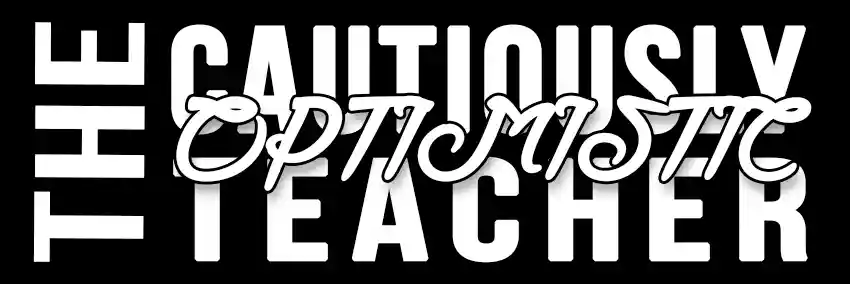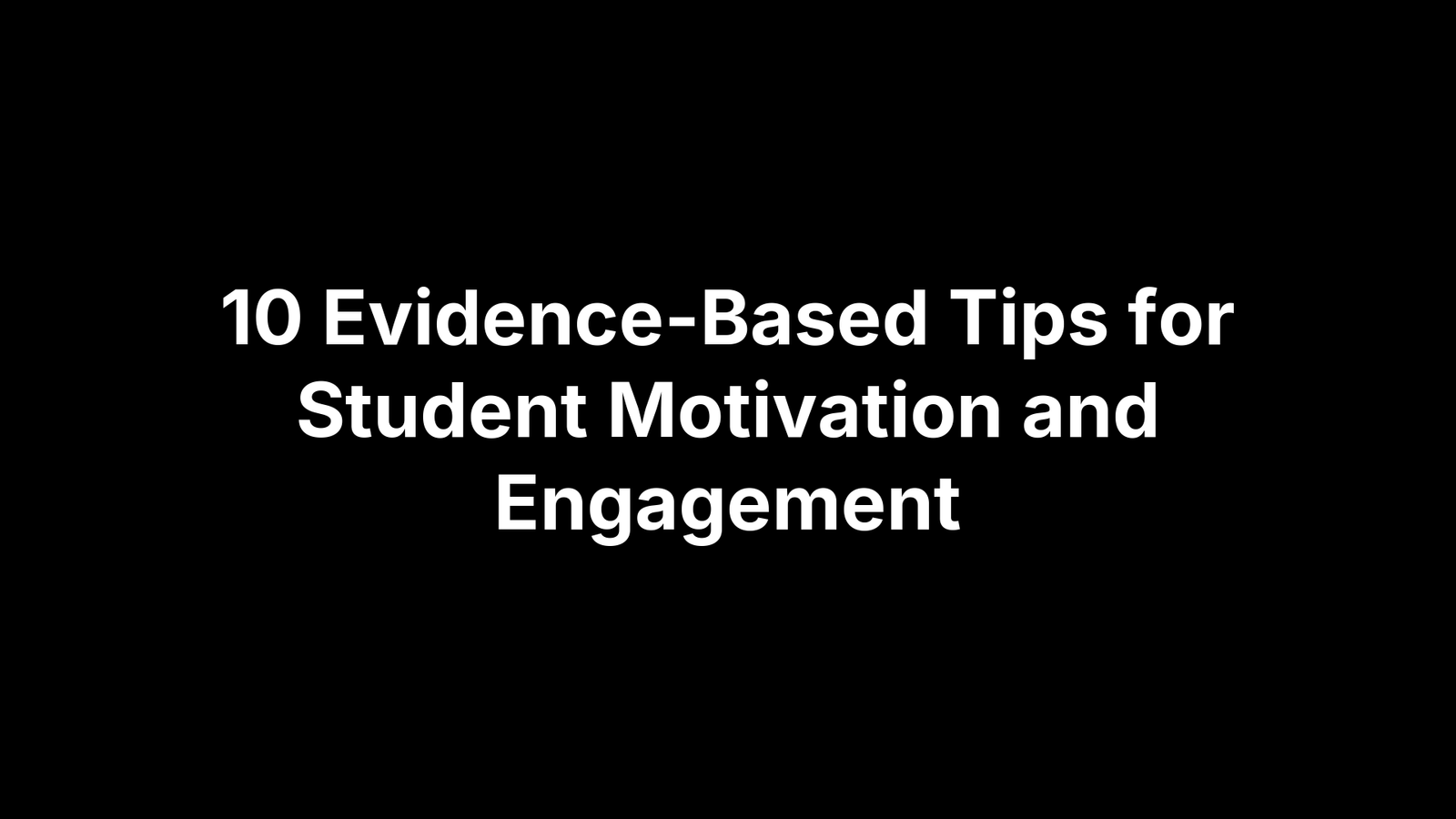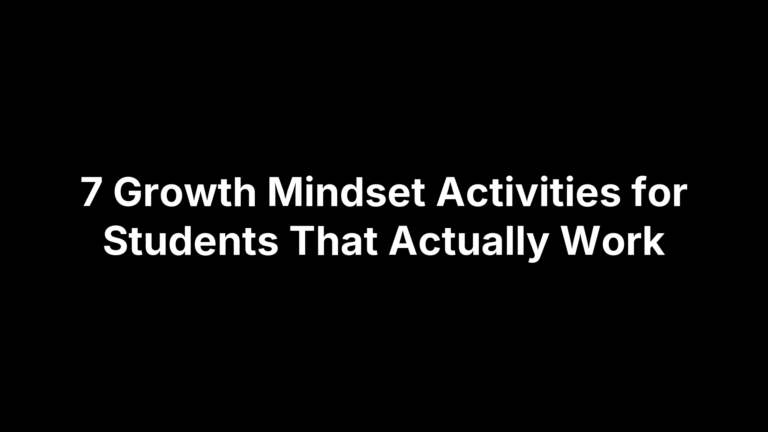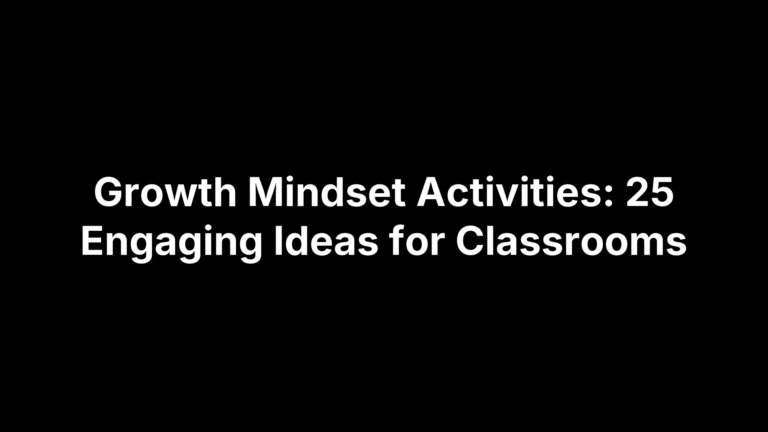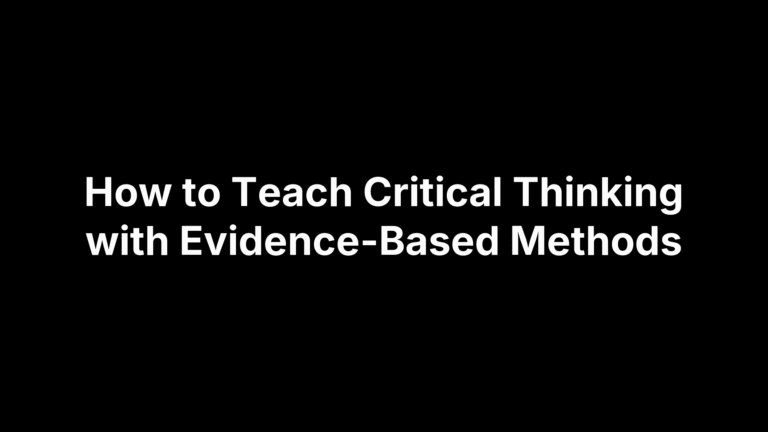10 Evidence-Based Tips for Student Motivation and Engagement
If you’re seeing glazed eyes, quiet discussions, or participation that swings from eager to absent, you’re not alone. Motivation and engagement don’t magically appear because we add a game, a new tool, or a pep talk. Students lean in when they feel a sense of purpose, competence, and belonging—and when the path to success is visible and attainable. The challenge is designing daily routines and tasks that spark effort for every learner, not just the self-starters.
This guide distills the strongest research on student motivation and engagement into 10 practical moves you can use tomorrow. For each tip, you’ll get a quick why-it-works summary, concrete steps to implement in any subject or grade, and simple ways to track impact. Strategies range from autonomy-supportive teaching and active learning cycles to clarity of outcomes, timely feedback, and universal design—plus smart uses of The Cautiously Optimistic Teacher’s AI tools to personalize without adding hours to your prep. Ready to turn compliance into curiosity and effort into progress? Let’s get to the first strategy.
1. Leverage The Cautiously Optimistic Teacher’s AI tools to personalize learning
Personalization is a fast path to student motivation and engagement when it reduces friction and raises relevance. Our AI suite—the Differentiated Instruction Helper, Worksheet Maker, Question Generator, and Report Card Commentor—helps you tailor tasks, supports, and feedback without adding hours to prep.
Why it works
Self-determination research (Ryan & Deci) shows autonomy and competence drive motivation, and Cornell’s guidance highlights value, choice, and clear expectations. Well-matched tasks and timely feedback make progress visible, so students lean in.
What to do
Start small by personalizing one routine this week with AI support.
- Differentiate tasks: Use the Differentiated Instruction Helper to tier goals, scaffolds, and extensions.
- Target practice: Generate leveled items with the Worksheet Maker for quick, aligned reps.
- Spark thinking: Use the Question Generator for retrieval, discussion, and exit prompts.
How to measure impact
Make engagement gains visible with quick, comparable data.
- Choice uptake: Percent of students selecting appropriately challenging options.
- Exit-ticket accuracy: By tier or support used, week over week.
- Student check-ins: 1–5 ratings on clarity, challenge, and relevance.
2. Create an autonomy-supportive classroom with high structure and low control
Students thrive when they feel trusted to make choices and supported to succeed. High structure with low control protects rigor while growing ownership—a proven combination for student motivation and engagement.
Why it works
Self-Determination Theory (Ryan & Deci) shows autonomy, competence, and relatedness fuel motivation. Controlling classrooms depress autonomy and raise frustration; supportive ones pair clear structure with choice. Gallup found students with strengths-focused schools and at least one inspiring teacher were 30× more likely to report high engagement.
What to do
Keep expectations explicit while widening options for how students meet them. Use language that invites agency, not compliance.
- Offer meaningful choices: formats, topics, partners, or timelines within guardrails.
- Use autonomy-supportive language: give rationales, avoid “should,” ask for perspectives.
- Keep structure visible: post agenda, success criteria, checkpoints, and available scaffolds.
How to measure impact
Look for rising initiative without dips in quality. Track simple indicators weekly.
- Participation spread: more voices in voluntary responses and discussion.
- Choice quality: percent choosing appropriately challenging options that meet criteria.
3. Connect content to students’ interests, cultures, and future goals
When students see themselves and their futures in the work, effort climbs. Relevance is one of the strongest levers for student motivation and engagement—especially when tasks feel meaningful now and useful later.
Why it works
Studies show that increasing content relevance boosts motivation, while Cornell emphasizes that students participate more when activities align with their goals and lives. Linking standards to identity and aspirations helps students perceive value and persist.
What to do
Make relevance routine, not a once-a-quarter event.
- Survey and use it: Quick interest/identity survey; weave results into examples and texts.
- Invite student hooks: Have students create “why this matters to me” openers.
- State the rationale: Tie each task to skills, careers, or community impact.
How to measure impact
Track perceived value alongside performance.
- Value ratings: Pre/post 1–5 “How useful was this?”
- Choice uptake: Percent selecting interest-aligned topics or texts.
- Exit tickets: Share one personal or future connection; tally specifics.
4. Build belonging through strong relationships and high expectations
Students invest more when they feel known and believed in—and when the bar is high with real support to reach it. Belonging plus rigor turns “Why bother?” into “I can do this,” a powerful engine for student motivation and engagement.
Why it works
Self-Determination Theory identifies relatedness, autonomy, and competence as core drivers of motivation. Gallup found students who strongly agreed their school built on strengths and that at least one teacher excited them about the future were 30× more likely to report high engagement.
What to do
Pair warmth with crystal-clear challenge.
- Know and listen: Greet by name, use quick check-ins, and integrate student interests.
- Co-create norms: Build community agreements; keep routines and expectations visible and consistent.
- Raise the bar with scaffolds: Set ambitious goals, offer supports, and give strengths-based praise; share positive updates with families.
How to measure impact
Look for rising belonging alongside steady rigor.
- Belonging pulse: Weekly 1–5 “I feel I belong/teacher cares” ratings.
- Participation spread: Count unique voices in discussions and voluntary shares.
- Attendance/behavior: Track dips in absences, tardies, and redirections or referrals.
5. Make learning outcomes and success criteria crystal clear
Clarity reduces cognitive load and boosts perceived competence. Cornell notes students engage more when outcomes, expectations, and assessments are explicit; structured, goal‑oriented classrooms make progress visible and motivating.
Why it works
When students know the destination and what quality looks like, they invest effort more confidently. Clear outcomes and success criteria align activities, feedback, and self-assessment, turning vague effort into targeted practice that pays off.
What to do
Make the target and what good looks like visible at point of use. Use plain language, align tasks to the outcome, and share a quick rationale students can repeat.
- Post 1–2 student‑friendly outcomes plus 3–4 success criteria.
- Show an annotated exemplar and co‑create criteria for new tasks.
How to measure impact
Look for tighter alignment between work and goals, not just higher grades. Students should be able to name the target and evaluate their own work against it.
- Micro‑exit: “State today’s goal and one success criterion” (≥80% accurate).
- Rubric calibration: Predicted vs. actual scores converge over time.
6. Give frequent, actionable feedback with time to use it
Feedback is the fuel that turns effort into improvement—and improvement into motivation. But comments alone don’t move learning unless students have time and guidance to act. Build short, predictable feedback cycles so progress becomes visible, fast, and worth chasing.
Why it works
Research grounded in Self‑Determination Theory ties timely, specific feedback to competence, a key driver of student motivation and engagement. Cornell’s teaching guidance also emphasizes regular feedback and self‑assessment in supportive environments where expectations are clear.
What to do
Keep feedback bite‑sized, task‑focused, and usable within the same class. Make revision a normal part of routine, not a special event.
- Embed revision: Build “feedback‑then‑revise” time into lessons.
- Be specific: Give one strength and one next step.
- Leverage peers: Use self/peer checks with clear rubrics.
How to measure impact
Monitor both speed and use of feedback, not just scores. Look for more revisions and tighter alignment to criteria over time.
- Turnaround time: Track submission‑to‑feedback intervals.
- Action rate: Count revisions made using your comments.
- Quality gains: Rubric growth between drafts; 1–5 clarity ratings.
7. Use active learning and retrieval every 15–20 minutes
Attention fades fast. Inject brief active learning and retrieval bursts every 15–20 minutes to reset focus, surface misconceptions, and keep every student thinking. Short, purposeful switches sustain student motivation and engagement without sacrificing rigor.
Why it works
Cornell’s teaching guidance recommends changing things up every 15–20 minutes and using active learning to spotlight key content. Low‑stakes retrieval and open‑ended questions (as Stanford suggests) make thinking visible and build competence—core drivers of motivation.
What to do
Plan lessons in short cycles: input, quick retrieval, and brief processing. Keep tasks low‑stakes and aligned to the day’s outcome.
- Quick routines: Think‑pair‑share, 1‑minute write, no‑notes recall.
- Low‑stakes checks: Credit‑for‑completion polls, mini‑quizzes, practice problems.
How to measure impact
Track whether the quick bursts boost accuracy and participation without slowing pace. Keep evidence simple and comparable.
- Recall trend: No‑stakes accuracy improves week over week.
- Participation spread: More unique voices during active segments.
8. Offer meaningful choices to increase student voice and ownership
When students get real choices within clear guardrails, they feel trusted—and effort rises. Choice turns compliance into ownership, increasing student motivation and engagement without lowering rigor.
Why it works
Self‑Determination Theory shows autonomy fuels motivation, and Cornell recommends offering students choices to boost participation and success. Meaningful options increase perceived value and competence, so students lean into the work.
What to do
Bound choices with explicit outcomes and success criteria.
- Design choice boards: formats, topics, or products that meet the same goal.
- Offer path options: flexible timelines, partner/solo, or resource menus.
- Co‑create rubrics: invite student input on quality indicators.
How to measure impact
Track initiative and quality, not just completion.
- Choice quality: percent of selections meeting criteria on first submission.
- Agency pulse: 1–5 “I had voice/ownership today” ratings; trend weekly.
9. Teach self-regulation, reflection, and mastery goal setting
Motivation sticks when students know how to improve. Teaching self‑regulation, reflection, and mastery goals builds autonomy and visible competence—key drivers of student motivation and engagement.
Why it works
Self‑determination research (Ryan & Deci) highlights autonomy, competence, and relatedness. Goal‑oriented routines—mastery goals, process plans, self‑assessment—make progress visible and turn errors into feedback.
What to do
Build a tight cycle students can run.
- Model SMART, mastery goals aligned to today’s criteria.
- Co‑create a process plan with a short checklist.
- Pause for self/peer checks using the criteria.
- Graph progress; analyze errors: keep one strategy, change one.
How to measure impact
Track rising self‑direction and steady growth.
- Goal recall: % naming goal and next step.
- Process fidelity: on‑time checkpoints; checklist completion.
- Growth evidence: rubric gains across drafts.
10. Plan for access and challenge with universal design and scaffolds
Plan for variability, not the “average” student. Build in access (scaffolds, models, language supports) and challenge (extensions, complexity, independence) so every learner moves toward the same grade‑level goals without watering them down—engagement rises when work feels doable and worth doing.
Why it works
Supportive classrooms pair high structure with low control and use scaffolds to bridge gaps to grade‑level content, making success possible even for learners not there yet. That builds competence and autonomy (Ryan & Deci), two pillars of student motivation and engagement.
What to do
Design the core task once, then layer supports and extensions. Keep outcomes fixed and pathways flexible.
- Clarify the target: Post outcome, criteria, and an annotated model.
- Preload access: Vocabulary previews, visuals, guided notes, and sentence frames.
- Chunk the process: Checklists, time checkpoints, and worked examples.
- Stretch options: Enrichment problems, open‑ended prompts, or independent application.
How to measure impact
Monitor whether more students reach the same standard with fewer bottlenecks. Look for growing independence alongside steady rigor.
- Access rate: Percent meeting grade‑level criteria with planned supports.
- Help requests: Fewer 1:1 rescue cues; more self‑initiated strategy use.
- Scaffold fade: Students dropping supports over time without performance dips.
Conclusion section
Motivation and engagement rise when students experience clarity, autonomy, relevance, and visible progress—backed by routines that make success achievable. Don’t overhaul everything; choose one move this week (clear criteria, retrieval bursts, or a tighter feedback‑revise loop), track a quick metric (exit‑ticket accuracy, value ratings, participation spread), and iterate. Small, consistent shifts compound into culture. For time‑saving tools, templates, and weekly strategies that make personalization doable, visit The Cautiously Optimistic Teacher. Your next class can feel more focused, hopeful, and productively busy.
